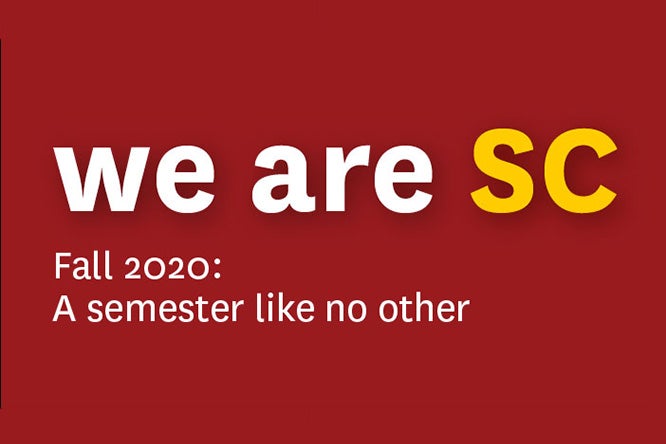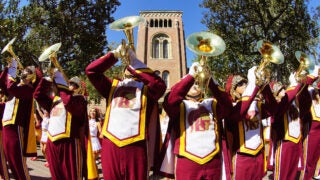USC Kaufman alums return to teach dance in a virtual world
Three alumni find themselves in a unique scenario: teaching a piece they learned as freshmen to current USC Kaufman students, only this time it’s through Zoom.
Just over a year after Paulo Hernandez-Farella, Stephanie Dai and Megan Yamashita graduated from the USC Kaufman School of Dance, the three of them returned to their alma mater to teach choreography to current dance students.
The three dancers, part of USC Kaufman’s inaugural graduating class, find themselves in a familiar scenario. The class sizes are small, they’re working with professors they learned from only a few years ago, and the piece is Dwight Rhoden’s ballet “RED/THE FORCE,” which they learned as freshmen. The main difference is that they learned the dance piece in a studio, and now have to teach it online.
“When we learned this four years ago, our class all came from completely different backgrounds and upbringings … so it was really that unifying piece for us,” Hernandez-Farella said. “It’s a great opportunity to get everyone on the same page.”
In addition to creating “RED/THE FORCE,” Rhoden also co-founded Complexions Contemporary Ballet in New York City with Desmond Richardson, who is an artist-in-residence at USC Kaufman and taught the piece to the trio during their first year at USC.
“Rhoden’s choreography is very big and expansive,” Yamashita said. “It’s really just a beautiful piece with beautiful music; I love it.”
Yamashita described the piece as “militaristic” in that the dancers are all in lines, each with different choreography. Dai described it as “full-bodied” and “technical.”
“It’s rooted in ballet, but it still breaks the rules where you’re encouraged to really push the limits of shapes, and it’s just this long string of movements that never end,” Dai said.
For Hernandez-Farella, the piece “has a legacy in itself already.”
“It has just sheer intensity and elegance,” Hernandez-Farella said. “When you’re watching it, you’re going to be completely immersed and you’ll just want to see it over and over again.”
A trio of alumni discover the difficulties in teaching dance online
All three alumni are currently with dance companies: Hernandez-Farella with Ballet Hispánico in New York, Dai with The TL Collective in Los Angeles and Yamashita with Complexions Contemporary. But much of their workload has declined due to the pandemic, which opened the door for the three — all of whom are currently in the L.A. area — to return to USC Kaufman.
The trio taught the piece to underclassmen during the first four weeks of the semester and are now teaching it to upperclassmen. Each alum was in charge of teaching a specific section. While one person taught, the other two, along with Associate Professor Patrick Corbin, watched the students.
“I chose Steph, Paulo and Megan because of their attention to detail and abilities to recall choreography,” Corbin said. “I was also aware of their aptitude for teaching in general.”
It really felt like you were just this crazy person in a room by yourself, teaching yourself how to dance.
Stephanie Dai
Though communication was much easier for the alumni with all three in the same geographic area, the actual teaching process had its fair share of challenges. From lagging connections and various student learning spaces, instructing over Zoom is challenging enough. Finding a way to teach dance and critique choreography online only ramped up the difficulty.
Both Yamashita and Dai said that the feeling of dancing in an empty room while 50-some students watch was definitely an adjustment.
“The first class was really rough in terms of Zoom fatigue, and there’s also such a lack of immediate feedback,” Dai said. “It really felt like you were just this crazy person in a room by yourself, teaching yourself how to dance.”
Hernandez-Farella, however, did not find it that difficult. This summer, the L.A. native rehearsed and recorded a piece virtually for Ballet Hispánico, and taught a summer program remotely. Heading back to USC Kaufman, Hernandez-Farella was fairly confident with Zoom, while admitting that in-person performing and teaching do provide a valuable morale boost.
“We’re really missing out on being able to watch each other firsthand, high-five our partner and feed off each other’s energy, because that’s something that’s so necessary for these group pieces,” Hernandez-Farella said.
USC Kaufman alums, students reflect on the challenges they’ve faced
If anyone can speak on the differences in learning repertory now versus a year ago, it’s USC Kaufman sophomore Lauren Brophy. She said her class is adapting well to the changes, but one of the biggest challenges is the lack of clarity when it comes to certain positions and specific details due to different camera angles and spatial restrictions. However, she added that being able to Zoom into rehearsal from home creates more opportunities for choreographers such as Rhoden and Richardson to work with students in rehearsal.
“While I do miss the energy of a full, focused studio, I am finding it beneficial to tune out the rest of the world for a little bit and focus with no additional distractions, which makes it easier to pick up choreography and retain notes,” she said.
Each of the three alumni instructors also spoke about parallels between the current cohort of freshmen and their experience as USC Kaufman’s inaugural class in 2015. For their first year, they did not have the Glorya Kaufman International Dance Center, which opened in the fall of 2016. Between navigating a new program, connecting with classmates and not really having their own space, the trio all said they can empathize with what their students are going through.
“We were actually in the Physical Education Building, sharing it with the ROTC,” Yamashita said. “Obviously learning through Zoom is really difficult for the students, but Paulo, Stephanie and I are all dealing with this, too.”
Even online, passion for dancing — and teaching — shines through
Even with the minor setbacks and adjustments, the trio said the one constant was the passion and dedication displayed from the students, regardless of location, time zone or whether they were performing in a bedroom or an actual dance studio.
It’s been a great opportunity … to give freshmen and sophomores a chance to talk to one of their peers.
Paulo Hernandez-Farella
“You can tell they have a wonderful work ethic, and they’ve been very engaged throughout the whole process,” Dai said. “Extra kudos to them for being on for the whole three-hour block because it is a lot, especially when you don’t have other people next to you to talk to or give you energy.”
Ask each one of the instructors about the effect 2020 has had on their personal careers and they’ll have pretty much the same answer: It hasn’t been easy. Each had plans that were forced to change, performances that halted or moves that never happened. None of them have even been on stage in months, which is why they said they’ve all enjoyed teaching the class so much: They get to continue practicing their craft and are able to serve as mentors to students, who are just as nervous about the future as anyone.
“It’s been a great opportunity across the board, to give freshmen and sophomores a chance to talk to one of their peers,” Hernandez-Farella said.
“I am a professional dancer, but I’m not one of their professors or their dean. I’m just at the front of the room assisting them and setting this repertory.”




